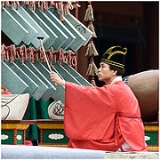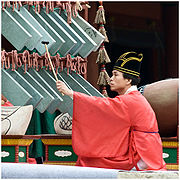
Jongmyo jerye
Encyclopedia
Jongmyo Jerye or Jongmyo Daeje is a rite held for worshipping the late kings
and queens
of the Joseon Dynasty
in Jongmyo Shrine
, Seoul
, South Korea
. It is held every year on the first Sunday of May. The Jongmyo rite is usually accompanied with the court music
playing (Jerye-ak) and dance
called Ilmu or line Dance. Jongmyo Jerye and Jeryeak were designated as the first of South Korea's Masterpieces of the Oral and Intangible Heritage of Humanity
by UNESCO
in 2001.
era and preserved from the Goryeo Dynasty to the last Korean Dynasty of Joseon
. Along with the ceremony for praying to the Gods of Earth for bountiful crops, it is considered Korea's highest-ranked rites. These practices have been lost in China but Korea still preserved it well.
The second is rituals for entertaining the spirits. It is started the rites of Jinchan, which serves 63 kinds of foods to the spirits. Then the king begin to serve the first wine offering to the ancestral rites (Choheonrye) followed by Aheongwan (Crown Prince) and Jongheongwan (Prime Minister). This ritual is followed by rite of reciting the prayer paper by people called Daechukgwan. Aheonrye and Jongheonrye are the rites of the second and third (last) of wine offering.
The third part is the last rites which are held to send off the spirits to heaven. Eumbok is an occasion of sharing foods and wine to the officiants. The Cheonbyeondu is the rite of removing all the foods served for the spirits. In Songsin, the Choheongwan and other officiants bows four times to send off the spirits to heaven. Mangryorye is the last rite held by burning the prayer papers and the king is reported by the Heongwan and Daechukgwan that the rituals and services are completed and all the officiants withdraw.
 During the rituals of Jerye, it were held together with the court music
During the rituals of Jerye, it were held together with the court music
playing (Jerye-ak) to bring an enjoyment for the spirits invited into the rites. Jerye-ak compositions played in the rites were Botaepyeong and Jeongdaeeop. There were also songs that accompanied the jerye-ak, named Jongmyo Akjang.
An elaborate performance of ancient court music (with accompanying dance) known as Jongmyo jeryeak (hangul: 종묘제례악; hanja: 宗廟祭禮樂) is performed there each year. Musicians, dancers, and scholars would perform Confucian rituals, such as the Jongmyo Daeje (Royal Shrine Ritual) in the courtyard five times a year. http://www.lifeinkorea.com/Travel2/77. Today the rituals have been reconstructed and revived. The Jongmyo Daeje has been designated as Important Intangible Cultural Property No. 56 and is performed every year in May. http://www.lifeinkorea.com/Travel2/77. The Jongmyo Jerye-ak, the traditional court music of Joseon, is performed by the Royal Court Orchestra and has been designated as Important Intangible Cultural Property No. 1.http://www.lifeinkorea.com/Travel2/77. This court music has its origins in Chinese court music that was brought to Korea during the Goryeo
period. http://www.lifeinkorea.com/cgi-bin/pictures.cfm?FileName=perform8. King Sejong composed new music for the ritual based largely on hyangak
(with some dangak
) in 1447 and 1462. http://www.lifeinkorea.com/cgi-bin/pictures.cfm?FileName=perform8.
Ilmu divided into two types of dance, Munmu and Mumu. Munmu is accompanied by Botaepyeong-ji-ak, with Yak (a three-holed bamboo flute) in the left hand and Jeok (a pheasant-feather tasseled wooden bar) in the right hand. Mumu is a military dance. The dancers move fastly by holding wooden swords and the rear four rows wooden spears in the front four rows .
King
- Centers of population :* King, Ontario, CanadaIn USA:* King, Indiana* King, North Carolina* King, Lincoln County, Wisconsin* King, Waupaca County, Wisconsin* King County, Washington- Moving-image works :Television:...
and queens
Queens
Queens is the easternmost of the five boroughs of New York City. The largest borough in area and the second-largest in population, it is coextensive with Queens County, an administrative division of New York state, in the United States....
of the Joseon Dynasty
Joseon Dynasty
Joseon , was a Korean state founded by Taejo Yi Seong-gye that lasted for approximately five centuries. It was founded in the aftermath of the overthrow of the Goryeo at what is today the city of Kaesong. Early on, Korea was retitled and the capital was relocated to modern-day Seoul...
in Jongmyo Shrine
Jongmyo
Jongmyo is a Confucian shrine dedicated to the memorial services for the deceased kings and queens of the Korean Joseon Dynasty. According to UNESCO, the shrine is the oldest royal Confucian shrine preserved and the ritual ceremonies continue a tradition established since the 14th century...
, Seoul
Seoul
Seoul , officially the Seoul Special City, is the capital and largest metropolis of South Korea. A megacity with a population of over 10 million, it is the largest city proper in the OECD developed world...
, South Korea
South Korea
The Republic of Korea , , is a sovereign state in East Asia, located on the southern portion of the Korean Peninsula. It is neighbored by the People's Republic of China to the west, Japan to the east, North Korea to the north, and the East China Sea and Republic of China to the south...
. It is held every year on the first Sunday of May. The Jongmyo rite is usually accompanied with the court music
Korean court music
Korean court music refers to the music developed in the Joseon Dynasty . Very little is known about the court music of earlier Korean kingdoms and dynasties.It was partly modeled on the court music of China, known as yayue...
playing (Jerye-ak) and dance
Korean dance
Dance in Korea began with shamanistic early rituals five thousand years ago and now ranges from folk dance to newly created and adapted contemporary dance.-Overview:Korean traditional dance originated in ancient shamanistic rituals thousands of years ago...
called Ilmu or line Dance. Jongmyo Jerye and Jeryeak were designated as the first of South Korea's Masterpieces of the Oral and Intangible Heritage of Humanity
Masterpieces of the Oral and Intangible Heritage of Humanity
The Proclamation of Masterpieces of the Oral and Intangible Heritage of Humanity was made by the Director-General of UNESCO starting in 2001 to raise awareness on intangible cultural heritage and encourage local communities to protect them and the local people who sustain these forms of cultural...
by UNESCO
UNESCO
The United Nations Educational, Scientific and Cultural Organization is a specialized agency of the United Nations...
in 2001.
History
The Jongmyo rites originated from the ancient Chinese era. They were practiced in Korea for the first time in SillaSilla
Silla was one of the Three Kingdoms of Korea, and one of the longest sustained dynasties in...
era and preserved from the Goryeo Dynasty to the last Korean Dynasty of Joseon
Joseon Dynasty
Joseon , was a Korean state founded by Taejo Yi Seong-gye that lasted for approximately five centuries. It was founded in the aftermath of the overthrow of the Goryeo at what is today the city of Kaesong. Early on, Korea was retitled and the capital was relocated to modern-day Seoul...
. Along with the ceremony for praying to the Gods of Earth for bountiful crops, it is considered Korea's highest-ranked rites. These practices have been lost in China but Korea still preserved it well.
Procedures
The Jerye procedures were divided into three parts. It is regarded as Korea's highest-ranked ritual, so it was held strictly and solemnly. The first part is the procedures to invite and greet the spirits. Most of the rites are held by king, officiants and his family. The first part's procedures are jagye (purification). Chwiwi is the part when the king and choheongwan (people who bring the wine for offering rituals) take the position into the chamber of the shrine. Then they wash their hands for greeting the spirits (gwansewi). In the Cheonghaengrye and Singwanrye rituals, they begin the rite of greeting the gods of Heaven and Earth by offering wine.The second is rituals for entertaining the spirits. It is started the rites of Jinchan, which serves 63 kinds of foods to the spirits. Then the king begin to serve the first wine offering to the ancestral rites (Choheonrye) followed by Aheongwan (Crown Prince) and Jongheongwan (Prime Minister). This ritual is followed by rite of reciting the prayer paper by people called Daechukgwan. Aheonrye and Jongheonrye are the rites of the second and third (last) of wine offering.
The third part is the last rites which are held to send off the spirits to heaven. Eumbok is an occasion of sharing foods and wine to the officiants. The Cheonbyeondu is the rite of removing all the foods served for the spirits. In Songsin, the Choheongwan and other officiants bows four times to send off the spirits to heaven. Mangryorye is the last rite held by burning the prayer papers and the king is reported by the Heongwan and Daechukgwan that the rituals and services are completed and all the officiants withdraw.
Jerye-ak

Korean court music
Korean court music refers to the music developed in the Joseon Dynasty . Very little is known about the court music of earlier Korean kingdoms and dynasties.It was partly modeled on the court music of China, known as yayue...
playing (Jerye-ak) to bring an enjoyment for the spirits invited into the rites. Jerye-ak compositions played in the rites were Botaepyeong and Jeongdaeeop. There were also songs that accompanied the jerye-ak, named Jongmyo Akjang.
An elaborate performance of ancient court music (with accompanying dance) known as Jongmyo jeryeak (hangul: 종묘제례악; hanja: 宗廟祭禮樂) is performed there each year. Musicians, dancers, and scholars would perform Confucian rituals, such as the Jongmyo Daeje (Royal Shrine Ritual) in the courtyard five times a year. http://www.lifeinkorea.com/Travel2/77. Today the rituals have been reconstructed and revived. The Jongmyo Daeje has been designated as Important Intangible Cultural Property No. 56 and is performed every year in May. http://www.lifeinkorea.com/Travel2/77. The Jongmyo Jerye-ak, the traditional court music of Joseon, is performed by the Royal Court Orchestra and has been designated as Important Intangible Cultural Property No. 1.http://www.lifeinkorea.com/Travel2/77. This court music has its origins in Chinese court music that was brought to Korea during the Goryeo
Goryeo
The Goryeo Dynasty or Koryŏ was a Korean dynasty established in 918 by Emperor Taejo. Korea gets its name from this kingdom which came to be pronounced Korea. It united the Later Three Kingdoms in 936 and ruled most of the Korean peninsula until it was removed by the Joseon dynasty in 1392...
period. http://www.lifeinkorea.com/cgi-bin/pictures.cfm?FileName=perform8. King Sejong composed new music for the ritual based largely on hyangak
Hyangak
Hyangak, literally "village music," is a traditional form of Korean court music with origins in the Three Kingdoms period . It is often accompanied by traditional folk dances of Korea, known as hyangak jeongjae...
(with some dangak
Dangak
Dangak is a genre of traditional Korean court music. The name means "Tang music," and the style was first adapted from Tang Dynasty Chinese music during the Unified Silla period in the late first millennium...
) in 1447 and 1462. http://www.lifeinkorea.com/cgi-bin/pictures.cfm?FileName=perform8.
Dances
The Jerye's dance is called Ilmu (line dance). Ilmu divided into Botaepyeong-ji-mu (dance to praise achievements of the former kings) , and Jeongdaeeop-ji-mu, (dance to praise the king's military achievements). Ilmu dances are performed by a group of 84 women dancers wearing purpled-clothing dance. They called Palilmu because they dance in 8 lines and rows.Ilmu divided into two types of dance, Munmu and Mumu. Munmu is accompanied by Botaepyeong-ji-ak, with Yak (a three-holed bamboo flute) in the left hand and Jeok (a pheasant-feather tasseled wooden bar) in the right hand. Mumu is a military dance. The dancers move fastly by holding wooden swords and the rear four rows wooden spears in the front four rows .

